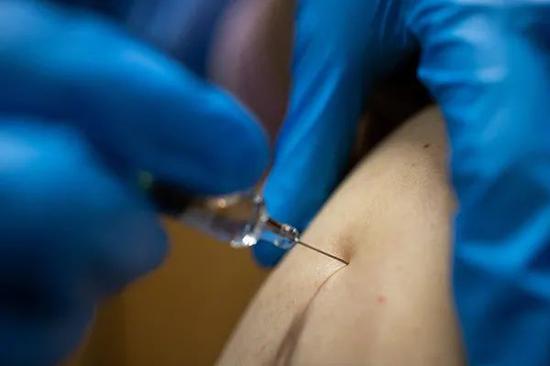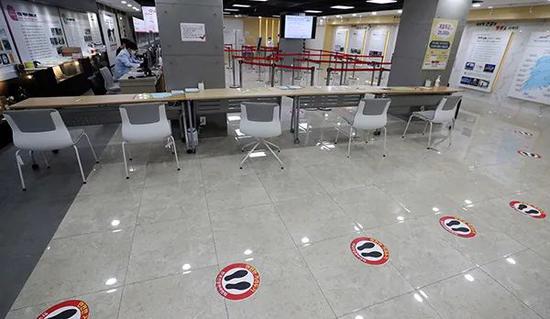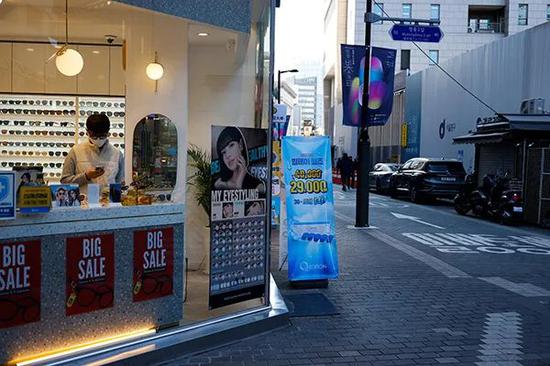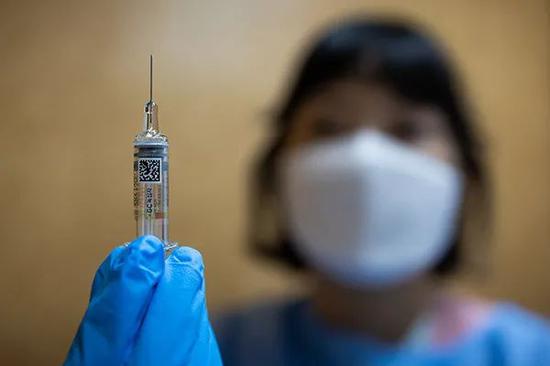Recently, many parts of South Korea are suffering from the third wave of COVID-19. As of December 8, the new cases in a single day have been maintained in triple digits for 31 consecutive days, and the epidemic prevention response level in the capital circle has risen to level 2.5.
Under the pressure of COVID-19 prevention and control, South Korea is also experiencing a “flu vaccine storm” – more than 100 deaths have occurred, causing strong panic among the public.
So, is the South Korean flu vaccine really the “real culprit” of death?
What is the root cause of this disturbance?
What impact will this have on South Korea’s future vaccination against the novel coronavirus?
Article | Wang Yuxuan Ph.D. in political diplomacy, Sungkyunkwan University, South Korea
Vaccine disturbance, a glimpse of the clue
South Korea has always actively popularized and promoted vaccination.
In 2017, South Korea had a flu vaccination rate of 84.4% among people over 65 years old, ranking first among OECD member countries (only 7% of the same population in our country), according to the World Health Organization for Economic Cooperation and Development

Affected by the COVID-19 epidemic, South Korea vigorously promotes influenza vaccination this year. The government plans to vacculate about 19 million people against the flu free of charge, mainly among teenagers, pregnant women and the elderly, starting from the end of September.
The influenza vaccines used are all quadrivalent vaccines, provided by eight domestic pharmaceutical companies and two overseas pharmaceutical companies.
In August, a survey conducted by Realmeter, a South Korean polling agency, showed that under the dual threat of influenza in autumn and winter and the COVID-19 epidemic, the proportion of South Korean people supporting influenza vaccination was as high as 89.3%.
On October 16, a senior high school student in Incheon died about 40 hours after being vaccinated against the flu. This is the first death of a vaccinated person in South Korea this year. Since then, the death toll has increased, and the influenza vaccine has been pushed to the forefront of public opinion.
So far, the number of deaths after being vaccinated against influenza in South Korea has reached 108. Of these, 98 people over the age of 60 accounted for more than 90%; 19 died within 24 hours of influenza vaccination, and 53 people died in more than 72 hours.
In terms of regional distribution, except for Ulsan and Shizong, there have been deaths in the country, but there has been no centralized distribution. The number of deaths in a single region does not exceed 20, and only four regions in the country have more than 10 deaths, including 15 in Gyeonggi Province and 14 in Seoul.
In fact, it is not the first time in South Korea that there has been an abnormal reaction or even death after vaccination against influenza.
According to the data of the Korean Institute of Disease Control, in the past five years, the number of abnormal reactions after influenza vaccination in South Korea has been 1,000-3,000 per year, with a peak of 3,743 in 2015.
For nearly 10 years, South Korea has lost fewer than 10 cases of death every year after being vaccinated against influenza. In 2009, there were eight influenza vaccination deaths in South Korea. Seven of the deaths were concentrated on October 5-22, all over 70 years old and carrying basic diseases.
The eighth death was a 65-year-old woman who was vaccinated against influenza on October 19 of that year. She began to develop Miller Fisher syndrome on the 21st and died four months later.
[Note: Miller Fisher syndrome is one of the exact side effects of influenza vaccine. Patients will have motor disorders, extraocular paralysis and other symptoms, which can seriously cause respiratory paralysis, autonomic nervous dysfunction, and even life-threatening.]
This death is the only influenza vaccine death admitted by the South Korean government in nearly 10 years.
The suspicion of “death” has caused controversy.
The frequent occurrence of such incidents makes South Korea deeply doubt about vaccine safety.
On 22 October, the Korean Medical Association proposed that the government should suspend the influenza vaccination program until it is confirmed to be safe.

On the same day, Zheng Yinjing, director of the South Korean Department of Disease Management, responded to the death after vaccination against influenza, saying that no clear causal relationship between the death and the vaccine has not been identified. The possibility of death of influenza vaccine itself is extremely low. Among the deaths, the vast majority of people are accompanied by diabetes, hypertension, cardiovascular diseases and other basic diseases, and there is a possibility of sudden deterioration of basic diseases and death.
Therefore, the investigation team believes that the possibility of a direct link between deaths and influenza vaccines is not very high, and it is not appropriate to stop the vaccination process called for by the government.
As we all know, no vaccine has proved to be completely side-effect-free.
However, there have been more than 100 deaths in South Korea after the flu vaccination, which is rare.
In addition, the omissions of the South Korean government in the custody and transportation of influenza vaccines have amplified the public’s unease.
According to the South Korean Influenza Vaccine Custody, Transmission Management Guidance, influenza vaccine should be in an environment of 2-8 °C during the custody and delivery process, and ensure the integrity and cleanliness of the vaccine.
However, in practice, some batches of vaccines were briefly at room temperature (20-30 °C) during delivery. In addition, some vaccine injections also appear incomprehensible substances.
The problems of “normal temperature exposure” and “white matter” have prompted the public to associate the causal relationship between influenza vaccine and death events.
Some public opinion and opposition parties in South Korea even suspect that exposure to “toxic vaccines” with room temperature or unknown substances is the direct cause of death of vaccinators.
In response, the explanation given by the Korean medical community is that if the vaccine is exposed at room temperature for a long time, it may lead to protein deterioration or the decline of vaccine efficacy.
However, the decline in efficacy is not the same as ineffective or toxic and harmful.
After investigation, the white substances appearing in some vaccine injections in South Korea are caused by the loose control of vaccines in the custody and transportation.
This white substance has been proven to be a non-harmful substance, and the puncture self-destruction syringe used during vaccination cannot be imported into the human body and will not affect the health of the vaccator.
At present, the investigation related to the “death” of influenza vaccine in South Korea has made the following new progress:
First, vaccines involving deaths are not provided by the same company, nor are they in the same batch.
It has been identified that these vaccines are supplied by five pharmaceutical companies, namely, GC Pharmaceutical Company in South Korea, SK Biotechnology and Yiyang Pharmaceutical Company, as well as Sanofi in France and GlaxoSmithKline in the United Kingdom.
Second, there are no specific side effects of influenza vaccine in the current death reports.
On the one hand, because it is impossible to force all the families of the deceased to agree to an autopsy, the case report has to make a judgment that there are no iconic side effects as a whole. On the other hand, considering what basic diseases the deceased himself has, whether he has taken other drugs before and after vaccination, whether there is physical fatigue or anaphylactic shock, etc.
Disturbing factors, it is difficult to determine the causal relationship.
According to this, South Korean officials believe that although there is a sequential relationship between influenza vaccination and frequent deaths at the time level, at best, it can only be considered to be related, and cannot prove causal.
On December 5, the Korean Disease Control Agency reported the results of the incident survey that the number of deaths after the influenza vaccination was 108, and the cause of death was confirmed to be not directly causally related to influenza vaccination.
Untrue report, confusing the public
On the one hand, the South Korean media carried out biased reporting to create explosive points without in-depth investigation and objective evaluation, resulting in the public opinion of the incident deviating from reason.

In response to the influenza vaccine scandal, South Korean media reports can be divided into three categories as a whole:
- Extract specific figures such as the number of deaths after vaccination, “normal temperature exposure” and the number of people vaccinated with white substances, as well as the relevant data released by official agencies on a daily basis, so as to rewrite the headlines.
- In terms of title and content writing, some media emphasize that “there is a problem with vaccinations provided by the government”, and pay close attention to sensitive issues such as “whether we should continue to believe in the government” to amplify the unease.
- Accurately capture the causes of unease among the South Korean people and over-exaggerate the “causal relationship” between influenza vaccine and deaths.
Most of these reports fail to accurately, detailed and scientifically verify the context of vaccine events, and most of them are “unfinished news” without follow-up reports, which disrupts the people’s complete and accurate channels for receiving important information.
On the other hand, the discussion of the truth of the vaccine scandal has become a political tool for different parties to attack each other, which seriously affects the authenticity and accuracy of the news.
In South Korea’s existing reports, extreme content such as “must be vaccinated”, “only 19% of civil servants above level 4 of the Ministry of Welfare are vaccinated against influenza”, “‘poison vaccine”, and the ruling party is leading the Republic of Korea to the abyss”.
It is reported that the South Korean government intends to introduce a plan to inoculate the coronavirus vaccine by the end of the year. The fallout of the influenza vaccine is likely to affect the public’s acceptance of the coronavirus vaccine, making the epidemic situation worse.
The government is dishonest and distracts people’s hearts.
With the death and the fermentation of public opinion, the speed of influenza vaccination in South Korea has slowed down, and there has even been momentum similar to the “anti-vaccine campaign” in Europe and the United States.
What is thought-provoking is why the public not questioned but deeply affected in the face of a large number of irrational reports?
A very important reason is the lack of credibility of the government.
South Korea’s early economic prosperity was based on the government-backed chaebol forces.
Under the long-term policy skew, South Korea’s chaebols have now developed into “monsters” that kidnap the economy and influence the government.
According to statistics, 85% of South Korea’s GDP is in the hands of the top five chaebol families.
Relying on strong economic strength, the chaebols have become a deeply rooted privileged class in South Korean society, and even go deep into public opinion, elections and other fields to contain each other with the government. Affected by this, the President of South Korea is also rarely finished well.
In recent years, South Korea’s political circles have been scandaluous, and the collusion between officials and businessmen, abuse of power, rampant privileges and other sinking difficulties.
The negative image of politicians continues to accumulate, deepening the South Korean people’s doubts about whether government policies really benefit the people.
When the MARS outbreak broke out in South Korea in 2015, people doubted whether the government would notify the epidemic as soon as possible. They believe that political elites and chaebols will deliberately delay the briefing in order to avoid harming themselves.
In this flu vaccine scandal, many people did not believe the government’s statement, and even asked the director of the South Korean Department of Disease Control and the Minister of Health and Welfare to take the initiative to vaccinate the flu vaccine to “prove that the vaccine is no problem”.
In addition, under the long-term control of the chaebols, social equity in South Korea has been seriously undermined.
Take the field of education as an example, there are 415 accredited higher education institutions in South Korea, mainly state, public and private. Among them, private education is rich in resources, abundant in financial resources, and abundant in people, and the level of education far exceeds that of other types.
According to the 2019 national university ranking data released by the Central Daily, private universities account for 9 of the top 10 universities in the comprehensive ranking and teaching results.
Moreover, South Korea’s education is overly dependent on the Seoul region, and the distribution of resources is seriously uneven. In the public security, procuratorial and legal system, the proportion of law majors in Seoul University exceeds 60%.
The unfair distribution of educational resources and unequal opportunities naturally make the quality of education rarely guaranteed, which in turn affects the overall education level and even the level of common sense of the people.
According to South Korea’s education department, in Seoul, more than 70% of college students believe that they have learned valuable knowledge during their college years.
In other regions, the figure is only 47%.
The unfair distribution of educational resources and the prominent inequality of opportunities have led to a decline in the overall education level of the South Korean people to a certain extent, becoming an irrational soil for breeding groups.
In this flu vaccine scandal, the South Korean people do not believe in the government and are blackmailed by false reports, which is the concrete manifestation of this unfair consequences of education.
The influenza vaccine scandal in South Korea has gone beyond pure medical malpractice to a multi-dimensional and multi-level social problem.
If the disturbance is to be completely calmed down, the rational choice of the people, the objective reporting of the media and the effective response of the government are indispensable.



